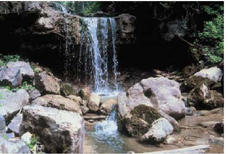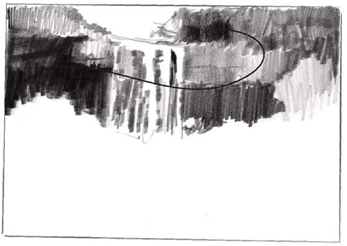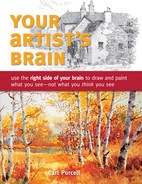CHAPTER 11
building a painting ON VALUE PATTERNS

REED THE TINKERER ![]() Watercolor
Watercolor ![]() 14″ × 21″ (36cm × 53cm)
14″ × 21″ (36cm × 53cm)

It is common to be overwhelmed by the many shapes of value that you encounter when looking at a scene. Your intellectual brain wants to separate every single shape and tackle them one at a time. As a result, your painting may have a fragmented or “checkerboard” appearance. However, by using your artist's brain, you can avoid this trap by linking shapes of similar values into a large pattern that touches several edges of your format. This strengthens the composition of the painting. It only took me a decade to learn how powerful this concept is. Master it, and you will be surprised at how well your paintings hang together.
Value patterns bring order out of chaos
Value patterns can do so much for your paintings, including:
![]() Connecting otherwise disparate pieces of similar value into one unified whole
Connecting otherwise disparate pieces of similar value into one unified whole
![]() Activating the format
Activating the format
![]() Leading the viewer's eye through the composition
Leading the viewer's eye through the composition
![]() Providing a structure on which to hang your detail
Providing a structure on which to hang your detail
Nothing builds cohesive structure in a painting better than connected patterns of similar values. By bringing all the little pieces of dark value together into one large, connected pattern of dark values, and making that pattern touch several edges of the paper, you will unify and strengthen your composition. For some reason, this concept seems to be the most difficult to learn. Our intellectual brain interferes with the process, demanding that we identify all the things that make up the pattern. And once the intellectual brain takes over, our paintings are finished.

Values Working Against Each Other
Notice how your eye seems to bounce in this composition. Each of these pieces of dark value is demanding your attention. There is no teamwork or pattern; the movement is completely random.

Values Working Together
Here the same dark shapes, plus a few additions, are unified into one complete pattern. Squint your eyes to see how they are all connected. The viewer's eye is led to the center where the most contrast occurs. This is a good example of harnessing the power of value patterns.
Practice evaluating value patterns
Just as with drawing, it is important to know how to evaluate the value patterns you see and feel the freedom to make changes for a painting. Look at your subject with a critical eye to determine which shapes are working within the composition and which ones are not. Remember, do not identify the items by name. Use your artist's brain to see them as value shapes, then eliminate the shapes that don't work and enhance the ones that do.
As you create value plans like the ones shown on this page, think ahead to other possibilities or variations of the pattern. The most creative question you can ask yourself is, “What would happen if I…?” Squint your eyes to see patterns that exist and to see possibilities in your drawings that don't yet exist.

Reference Photo
This rural scene has some good points and, like most scenes, it also has some aspects that could cause chaos in a painting.

A Sketch, Not Necessarily a Plan
This drawing of the subject has light, dark and middle values distributed exactly as they appear in the photo.

A Value Pattern = A Painting Plan
This is the same subject, with some modifications. It certainly looks better dressed up in a value pattern that extends to all edges of the picture. Squint your eyes to better see the patterns of dark and light.
Simplify nature's complexity with value patterns
Using your artist's brain to think in terms of value patterns allows you to simplify the dizzying array of things you find in nature. An isolated shape of dark draws attention to itself. If you don't want it to be a center of interest, merge it with a larger pattern of darks. If you can't tie it into a pattern, then get rid of it.

Reference Photo
Every time you evaluate shapes and patterns in a subject, you will find shapes that fit nicely into a coherent whole and those that don't. This scene has a powerful sweeping shape of dark that pulls the viewer's eye across the top part of the format to the light shape of the waterfall. Build around this. The scene also has a series of unconnected darks in the foreground rocks.

Connect Value With an Initial Sketch
Notice how the pattern moves across the top third of the paper, then turns back across the very top. Now we need to connect it to some values in the foreground. After doing this sketch, I asked myself, “What would happen if I moved the white over to the right, so the viewer's eye travels farther before moving downward?” The answer can be found by doing another rough, five-minute value pattern sketch.

Make Adjustments in a Second Sketch
Switching the location of the white value shifts the emphasis out of the center. Now activate the foreground by adding values to the basic shape. There are probably hundreds of different patterns that would work. Think connected darks, not “this rock and then that rock and then…”
Compare this final plan to the photo. Notice how much simpler the foreground is. Now there isn't any competition with the center of interest.

SERENITY FALLS ![]() Watercolor
Watercolor ![]() 21″ × 24″ (53cm × 61cm)
21″ × 24″ (53cm × 61cm)
Translating the Sketch Into a Painting
In this case, I may have gone a little too far with the finishing details. But the value plan in which the values were organized into a cohesive pattern saved me from slavishly copying the photo. Most of the time I complete a drawing on location and take a reference photo. Later when I compare the two, I always like the drawing more. I use the photo only for detail reference once I have created the basic painting.
